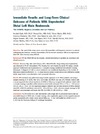Identificador persistente para citar o vincular este elemento:
https://accedacris.ulpgc.es/handle/10553/75042
| Título: | Immediate Results and Long-Term Clinical Outcome of Patients With Unprotected Distal Left Main Restenosis The CORPAL Registry (Cordoba and Las Palmas) | Autores/as: | Ojeda, Soledad Pan, Manuel Martin, Pedro Mazuelos, Francisco Suarez de Lezo, Javier Romero, Miguel Segura, Jose Pavlovic, Djordje Medina, Alfonso Suarez de Lezo, Jose |
Clasificación UNESCO: | 320501 Cardiología 320704 Patología cardiovascular 321307 Cirugía del corazón |
Palabras clave: | Coronary-Artery-Disease Drug-Eluting Stent Bypass-Surgery Bifurcation Lesions Intervention, et al. |
Fecha de publicación: | 2014 | Publicación seriada: | JACC: Cardiovascular Interventions | Resumen: | Objectives The goal of this study was to assess the immediate and long-term outcomes in patients undergoing percutaneous coronary intervention (PCI) for in-stent restenosis (ISR) in an unprotected distal left main coronary artery (UDLM).Background PCI for UDLM-ISR can be complex. Limited information is available on procedural and clinical outcomes. Methods Between May 2002 and February 2011, UDLM-ISR after drug-eluting stent implantation was observed in 79 of 1,102 patients (7%). Seventy-five were treated by repeat PCI using a simple approach (balloon/in-stent implantation) or a complex strategy (additional stent/double-stenting technique). A diagnosis of mild or severe restenosis was considered depending on the number of bifurcation segments affected (1 vs. >1). Major adverse cardiac events (MACE) were defined as cardiac death, target lesion revascularization, and myocardial infarction.Results ISR treatment was performed using a simple approach in 44 (58%) patients, and using a complex strategy in 31 (42%). After 46 +/- 26 months, the MACE rate was 22%. Patients treated with a simple approach had a lower incidence of MACE at follow-up compared with patients treated with a complex strategy, regardless of the restenosis extent (mild restenosis: 93% vs. 67%, p < 0.05; severe: 70% vs. 23%, p < 0.05). On Cox regression analysis, diabetes was the only predictor of MACE (hazard ratio [HR]: 4.94; 95% confidence interval [CI]: 1.03 to 23.70; p < 0.05), whereas a simple strategy for ISR treatment was associated with lower risk (HR: 0.25; 95% CI: 0.08 to 0.79; p = 0.02).Conclusions PCI for UDLM-ISR is safe and feasible, with a high rate of procedural success and an acceptable long-term MACE rate. A simple strategy, when applicable, appears to be a good treatment option, associated with a lower event rate at follow-up. (C) 2014 by the American College of Cardiology Foundation | URI: | https://accedacris.ulpgc.es/handle/10553/75042 | ISSN: | 1936-8798 | DOI: | 10.1016/j.jcin.2013.06.017 | Fuente: | Jacc-Cardiovascular Interventions [ISSN 1936-8798], v. 7 (2), p. 212-221, (Febrero 2014) |
| Colección: | Artículos |
Citas SCOPUSTM
16
actualizado el 08-jun-2025
Citas de WEB OF SCIENCETM
Citations
14
actualizado el 08-jun-2025
Visitas
91
actualizado el 17-may-2025
Descargas
218
actualizado el 17-may-2025
Google ScholarTM
Verifica
Altmetric
Comparte
Exporta metadatos
Los elementos en ULPGC accedaCRIS están protegidos por derechos de autor con todos los derechos reservados, a menos que se indique lo contrario.
